The House that Eats the Rabbit (Review & Facts About the 2021 Cosmotropia de Xam's Film)
In this article, I will tell you about the film The House that Eats the Rabbit
by Cosmotropia de Xam. I will share a few facts about the filming process, the
director’s own comments, and tell you about interesting things you can see in
the movie.
Now let’s cut to the cheese.
Plot Summary
The House that Eats the Rabbit is inspired by the book
Alice's Adventures in Wonderland and
Through the Looking Glass by Lewis Carroll. It features characters from
the books and other references to the story.
One Alice, lost in the
waters of infinity, is helped by another Alice who invites her to her house.
Bizarre things are happening there. Things the other Alice does not
understand. Further events unfold up the rabbit hole, where Alice meets the
White Rabbit, her Subconsciousness, and the Cheshire Cat, and plans about a
mad tea party are unveiled.
There is a narration telling a surreal and mysterious story and even
dialogues. As it’s always the case with the films by CdX, you have enough
space for your imagination to come up with your own understanding of the
plot.
Cosmotropia de Xam says that you can watch the film on
different levels of understanding: a narrative one, a religious level, a
psychological level with evolving psychograms etc. So discovering the hidden
elements is never a boring experience.
Vibe
The House that Eats the Rabbit is the return to the vintage visual style of Cosmotropia de Xam’s previous films: Diabolique (2013), Phantasmagoria (2017) and Phantasmagoria 2: The Labyrinths of Blood (2018), Acid Babylon (2020), and others.
The vintage post-production video filter, actresses’ attire, and room interiors create the ambiance similar to the one in the European cult classic exploitation films from the 70’s the director is an avid fan of (you can learn more about his tastes from my interview with Cosmotropia de Xam).
This time, the soundtrack was recorded completely by Mater Suspiria Vision. It’s full of nice soft and dreamy tunes consisting of vintage spacey electronic cosmic sounds. The score is released separately as the album Kosmische Musik. This album is a tribute to the early synth and organ sounds of the 1970’s that you can hear in the music by early Tangerine Dream, Cosmic Jokers, and Terry Riley.
As it’s usually the case with Cosmotropia de Xam’s films, the whole thing feels like a dream with multiple scenes transferring one to another in an unrealistic way — so-called dream logic (just like in Lewis Carroll’s story). However, this time the overall vibe is soft, relaxing, and sometimes humorous rather than harsh and nightmarish, although nightmarish elements aren’t missing.
Meaning
To avoid spoilers, I suggest that you read this section after watching the
film.
I had a hard time trying to understand the plot (like with
many other art house films I’ve watched). I had to watch it twice and then
have Cosmotropia de Xam explain it to me. Here are a few clues given by the
director for viewers like me whose realist mindset prevents them from
connecting the dots into a story.
Clues from the Director
Cosmotropia de Xam:
The film is multi-layer but of course there is a simple story:
One Alice wants to become the Red Queen but needs the other Alice and the
Key of Time to become her. That's the main layer. The other layers go deeper
into the psychograms of both.
Pay attention to the flow of time. It’s the focal point of the
story. Pay attention to what happens to the Key of Time at the end and how the
story changes depending on this.
 |
| Pay attention to the time. Sometimes it passes normally: tic-tac-tic-tac... But sometimes it's tic...tic...TAC... tic...tic...TAC... |
When you see oblong objects (wires, bands, strings, etc) that actors hold in their mouths in Cosmotropia de Xam’s films, this symbolizes communication. The director comments on the scene where white Alice is being fed by black Alice with what looked to me like black spaghetti.
What you saw as black spaghetti was for us a communication device within a ritual. There is a similar aesthetic as with the strings coming out of the mouth — a recurring element. Someone doing an analysis would see these things having a psychological meaning. There is also a connection between the mouth elements and the lack of speech… in general in my movies.
You need
to pay 100% attention to the chair scene [at the beginning of the film, in the attic, right after white Alice goes up the stairway] and read the subtitles attentively — if you don't, the film will leave
you at that point behind.
The meaning of some of the phrases:
Cosmotropia de
Xam:
"Too many have read Carroll's book and believe it." is mainly about the
classic Alice story and that this film is another story.
"In
their dreams, they dream the lives of others." is about switching characters [the same actresses play different characters]. Cheshire Cat and Red Queen are states of metamorphosis.
My Attempt to Interpret the Film
To connect the events into a story, there is no absolute necessity to go deep into symbolism trying to translate the characters and events into realistic or commonly known concepts. However, you may do it if you like.

|
|
I had a hard time looking for the way to assemble the events in the film
into a story. |
Below is my conversation with the director after watching the film the second time, taking into consideration hints that he had given me after my first viewing:
Gene Willow:
I've just watched the film again trying to connect your clues into a story.
I still couldn't do it. I had a couple of ideas of possible interpretations,
but every time new unclear details appeared and ruined my theory.
First,
I thought that at the beginning, white Alice was what the fans of the New
Age esotericism call a sprite — an entity who enters an embryo to be born as
a human and start the evolution of the soul.
At the beginning of
the film, as the narration says, she is at the “shore of Infinity” — the
sprite’s initial state, in nothingness, beyond the time. She leaves this
shore to enter “the mirror of time” — our normal world ruled by the time.
This means that she becomes a human embryo inside black Alice — her future
mother. Black Alice "invites her to her house" — she invites the baby to her
body and to her life by becoming pregnant.
They communicate ("spaghetti" scene): the mother talks to her future daughter. The white Alice,
still unborn, travels to her mom's head (attic). Daughter Alice learns that
the house (her mom's body) is "old and in decay": her mom is old and ill.
And there is a tea party planned with the "glasses of eternal life filled":
her mom's upcoming death. Also, black Alice in the attic looks like an old
lady which kind of supports this theory. Like her mother got pregnant too
late to give her birth, is old and ill, and is going to die?
“The
house keeps the Rabbit captive.” — Who is the Rabbit? Black Alice's soul who
will be released after her death?
“The house is built on the Red
Queen's grave.” Is the Red Queen the child that mom-Alice used to be in the
past? Like this child is "dead" meaning the time has passed and there is no
child anymore — there is only an adult grown of this child: “house (mother
Alice’s body) built on the child's grave (developed from her young
self)”?
White Alice (who is still a new human soul in the embryo)
wants to become the Red Queen (her mom in her mom’s childhood). White Alice
doesn’t want to simply be born as a new person. She wants to literally be
her mother in her mother’s childhood. To possess her body and become her.
But this is impossible now, because the time has passed, her mother has
grown old, there is no Red Queen (little girl) anymore. The time is the
cause of this. So white Alice needs to destroy the time to find the piece of
time where her mother was a child.
Then, after saying "The house
is built on the Red Queen's grave", black Alice says "Too many read
Carroll's books and believed it. They are daydreaming. In their dreams they
dream the lives of others. They are given a pill, they don't notice their
metamorphosis". — I can't imagine what this means. [See the previous section where the director answers these questions.]
I think at this point I started to think that my previous
theory, about the mother and daughter, was false. That maybe White Alice is
the character from the book while black Alice is the real person — Alice
Liddell — who was the model for Lewis Carroll’s book character. And this
real Alice is now an old lady. So the book character (imaginary entity)
wants to become the real life Alice. But not at Alice Liddell’s present age,
while she is an old lady. Imaginary Alice wants to become real Alice in real
Alice’s childhood. And similarly to the mother-daughter interpretation, she
has to destroy the time to accomplish her goal.
Then there is the
scene with the Temple. When black Alice is telling the myth about Adam and
Eve, I imagined that the fact that the Rabbit was their descendant, means
that by eating the forbidden fruit, they created all kinds of problems in
the human body: God made them mortal, subject to DNA fails, illnesses, etc.
So is Rabbit Alice's illness and not the soul? If so, this doesn't work well
with the fact that it's the house's (Alice's body's) captive. A soul works
better with this idea than illness.
Then black Alice says "Too
many people wanted to become the Red Queen". And that there was a sound that
could guide them that the Red Queen once heard... So this looks like my
previous theory about the Red Queen symbolizing Alice's childhood is wrong.
The Queen is a separate entity from black Alice. I don't understand who she
is.
At this point I got lost, and could no longer join any ideas
into one story. Neither do I understand who Cheshire Cat is [see the director’s answer in the previous section]. And why white Alice is outside the house during the Mad Tea Party. I
remember this happened after eating the clock, but I don't understand why
she is outside.
Those were my ideas when watching the film with
your clues in my mind and trying to be much more attentive this time. I even
took notes on paper. This didn't help much.
Cosmotropia de Xam: It's an interesting version of interpretation.
Gene Willow:
Those are failed attempts to interpret it. Because other facts contradict
my initial ideas.
Cosmotropia de Xam:
It's not failed because the time has changed within the movie.
Mira Kohli’s Comments
 |
| Mira says I got it wrong. |
This movie isn't about a mother-daughter theme or anything dynamic between any women. At least from my point of view.
My personal interpretation, which I won't share in detail with you, is a mixture of the things I experienced with this house in 2017— philosophical and psychological ideas.
I would recommend people to watch this movie from a metaphysical perspective.
Some clues: I am not sure if there are many characters or just very few, maybe just one, represented in different aspects. Maybe it was all a dream the house itself dreamt. It is an old house that has "seen" many people come and go for more than a hundred years.
I have always wondered what time feels like, if you presume a house or a tree has some form of consciousness.
Communication really plays a major role too. All I can say is there is, of course, no right or wrong interpretation of this movie, as each interpretation will say more about the interpreter than about the movie itself.
Cast and Characters
The House that Eats the Rabbit is a continuation of the director’s
collaboration with Mira Kohli (Alice and Cheshire Cat) and Marijana Mladenov
(the other Alice). They both played the main roles in Cosmotropia de Xam’s
previous film —
The Inferno Index (2021). Mira also appears as one of the leads in Space Necronomicon, a 2023 movie.
Adriani Schmidt plays another main role — the White Rabbit. Her
character also reminds the Mad Hatter. I loved the image she created by
skillfully designing this inventive makeup and attire. Adriani also plays the
Subconsciousness.
In one scene, we can see Olga Mladenov playing the violin. Olga is
Marijana’s sister whose music we also hear in
The Inferno Index.
Larissa Littwin (the daughter of Marcus
Littwin who played in The Inferno Index) recorded the narration. Larissa (togethter with her sister — Janet Littwin) had also played a vampire child in Metamorfosia, a 2014 film by Cosmotropia de Xam.
Sascha
Gutkowski, Mira’s former colleague from her progressive metal band In
Morpheus' Arms, appears in the last scene — at the table during the Mad Tea
Party.
Filming Process
The House that Eats the Rabbit was shot in five days. The filming process was intense. On the first day, the crew worked for fourteen hours in a row. Cosmotropia de Xam didn’t want to repeat the situation with his previous work, The Inferno Index, which had taken five months to shoot because of the COVID-19 pandemic restrictions.
I'm super happy that we can realise a new project again: there will only be a short time to do this: the pandemic restrictions aren't over yet — said the director after the first day of filming — The worst things are the restrictions. Now we have nearly zero here. But it will change again very soon.
Tomorrow and Wednesday are the closing scenes including the White Rabbit and the Tea Party. So the main project was based around 5 days out of 10 days in a row. — shared the director before finishing the filming. — It was very intense to do a project like this in five days. But there was an intense flow like in a music session.
Cosmotropia de Xam compares the film to his previous works:
The Inferno Index and Phantasmagoria 1 & 2:
The Inferno Index is a modern movie while this one goes back to the vintage
style of Diabolique, Phantasmagoria etc.
With The Inferno Index, we always filmed in a "more controlled", less passion-driven way. The scene with the ring took one full day. Now, this was more like visiting and discovering a foreign city. Phantasmagorias were the same — also more like city discovering, passion driven, and inspired by place and time.
Typically for CdX’s works, The House that Eats the Rabbit contains homages to other films. Apart from cult classics (the scythe fight in Fascination (1979) by Jean Rollin and the blurry tea drinking scene like the ending of The Strange Case of Dr. Jekyll and Miss Osbourne (1981) by Walerian Borowczyk), it also references Cosmotropia de Xam’s own movies — Phantasmagoria, Acid Babylon, and probably others.
Speaking of the film Fascination, I made these T-shirt designs. Download them for free (as well as my 50 other b-movie shirt prints) and order a shirt from any print-on-demand service you like.
One of the references is a church with an unusually modern ornament on its walls.
Cosmotropia de Xam:
It’s a historical location of the movie "Phantasmagoria 2" — it was nice to
revisit the location. It's a church near Dusseldorf which was merged with
the locations from Jess Franco's movies [in Phantasmagoria 2]. Even Rachel [Rachel Audrey]
who had been there [when filming Phantasmagoria 2]
wasn't aware that we used it again because of the different angle, which is
good.
Cosmotropia de Xam: Imho, both actresses already have a better appearance within the scenes we filmed here than in The Inferno Index.
Do you mean their look, because of the attire or they play better? — I asked.
Everything. You can improvise very well on an Alice-themed story and then mash it up the CdX way. Outdoor filming can be a mess. When you do outdoor at important places, there is magic and you feel inspired like in Phantasmagoria 1+2. But when you film outdoors, so many factors can destroy the energy.
The church from Phantasmagoria 2 nearly worked well with the energy, even if that was a revisit of my own movie. But it was also revisiting the old time, pre-COVID. And we discovered images I don't have in Phantasmagoria 2, like the "White Rabbit”.
Cosmotropia de Xam: So don't get me wrong: I like The Inferno Index, but not so much from a personal point of view — more from a professional point of view, but my movies are more personal.
CdX comments on the narration for The House that Eats the Rabbit:
It’s recorded by Larissa Littwin, one of the then-children from Metamorfosia (2014). She is a young adult now. This film needs a clear and young voice. The innocence is a good contrast to bizarre images.
Interesting Facts
- Adriani Schmidt (White Rabbit) and Marijana Mladenov (Alice in the white dress) never met within the filming: “We filmed with Marijana on day 1+2, and 3. And with Adriani — on day 4+5.” — says Cosmotropia de Xam.
- The scene where white Alice is following the Rabbit was completely improvised by Marijana. The only instruction Cosmotropia de Xam gave to Marijana is to climb in slow motion, in a weird manner and like she can’t walk.
- Cosmotropia de Xam: Mira spent so much work on the set design for the table. She prepared all these obscure glasses and everything. It was a day of work.
-
Most of the film was shot in the house where Mira lives. The house is from
around 1900.
Where to Watch The House that Eats the Rabbit
The film is available:
- for online viewing on Vimeo
- as a physical release in multiple configurations at Phantasma Disques’ Bigcartel.
I created this blog for like-minded people with weird taste for unpopular, obscure, and sleazy films and music. If you feel our tastes are similar, let's be email friends. You can also reach out to me if you need help in finding any rare film or music mentioned in by blog.




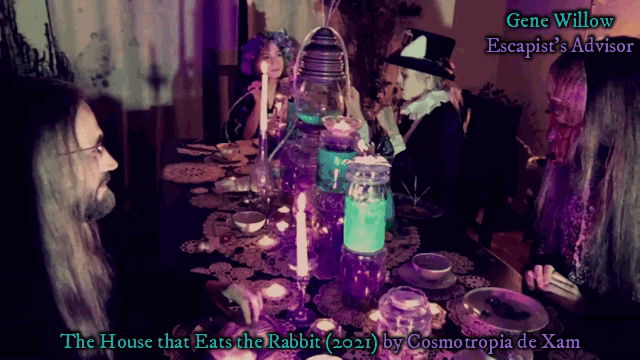
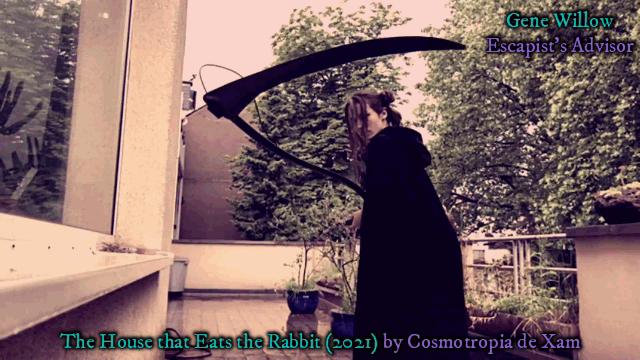

%20T-Shirt%20(Myriam%20Watteau).jpg)
%20T-Shirt.jpg)
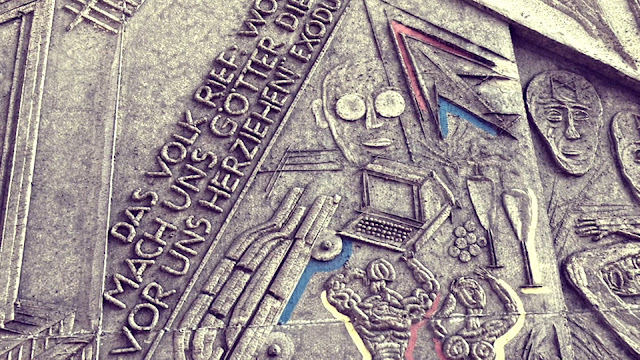

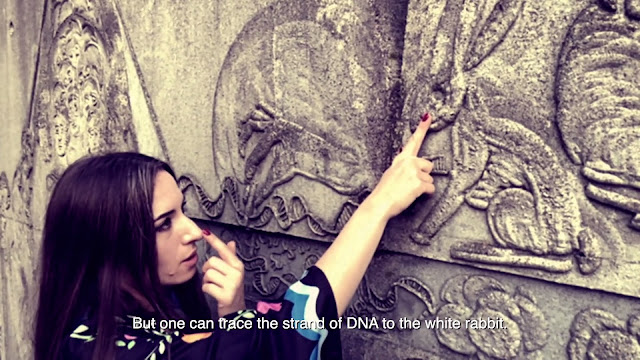

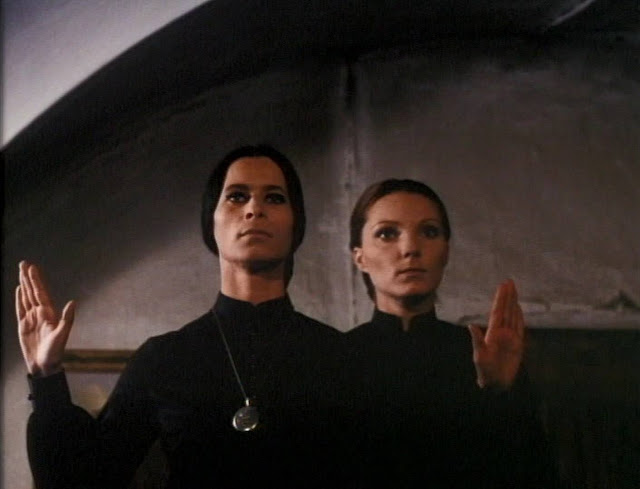


Comments
Post a Comment